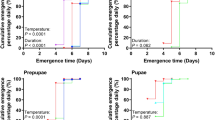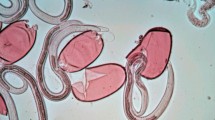Abstract
Techniques to preserve the infective third-stage larvae (L3) of gastrointestinal nematodes are of considerable interest to preserve rare species and to maintain a stable source for routine experimental infections. This study compares the relative pros and cons of the two most common techniques, cryopreservation and refrigeration by comparing how they influence consequent infection outcome parameters in terms of life-history traits and fitness as a function of time using the gastrointestinal nematode of sheep Haemonchus contortus as a study species. Establishment capacity was found to be significantly reduced in cryopreserved stocks of L3 compared to refrigerated stocks, but this was followed by significant increases in their fecundity. Refrigeration did not affect L3 stocks consequent fitness by 16 months (the maximum examined) although they did incur a significant reduction in establishment, followed once again by an augmentation in fecundity. The study highlights potential areas for bias in comparing studies using L3 larvae maintained for different periods of time under different techniques.
Similar content being viewed by others
References
Baermann G (1917) Eine einfach methode zur auffindung von Ankylostomun—(Nematoda)—larven in erdproben. Welteureden Batavia Geneesk. Lab Feestbundel 41–47
Cabaret J, Ouhelli H (1984) Fertility of parasitic strongyles in the digestive system of sheep under natural conditions. Rev Med Vet 135:627–633
Campbell WC, Blair LS, Egerton JR (1973) Unimpaired infectivity of the nematode Haemonchus contortus after freezing for 44 weeks in the presence of liquid nitrogen. J Parasitol 59:425–427
Chehresa A, Beech RN, Scott ME (1997) Life-history variation among lines isolated from a population of Heligmosomoides polygyrus bakeri. Int J Parasitol 27:541–551
Chylinski C, Lherminé E, Coquille M, Cabaret J (2014) Desiccation tolerance of gastrointestinal nematode third stage larvae: exploring the effects on fitness and the factors influencing survival. Parasitol Res. doi:10.1007/s00436-014-3938-1
Chylinski C, Blanchard-Letort A, Neveu C, Cortet J, Cabaret J. Parasitic gastrointestinal nematodes coping with chemotherapy, resistant hosts and unfavourable climatic environments: an experimental evaluation. Submitted to Molecular Ecology. Under review
Gaba S, Chadoeuf J, Monestiez P, Sauve C, Cortet J, Cabaret J (2006) Estimation of abomasum strongyle nematode infections in sheep at necropsy: Tentative proposals for a simplified technique. Vet Parasitol 140:105–113
Gasnier N, Cabaret J, Moulia C (1992) Allozyme variation between laboratory reared and wild populations of Teladorsagia circumcincta. Int J Parasitol 22(5):581–587
Kerboeuf D (1978a) The effects of time and temperature of storage on the infectivity of third-stage larvae of Heligmosomoides polygyrus (: Nematospiroides dubius). 1. Effects on the development to the adult stage in mice. Ann Rech Vet 9:153–159
Kerboeuf D (1978b) The effects of time and temperature of storage on the infectivity of third-stage larvae of Heligmosomoides polygyrus (: Nematospiroides dubius). 2. Studies on the fecundity of female worms as a function of the infectivity of third-stage larvae. Ann Rech Vet 9:161–168
MAFF. Ministry of Agriculture Fisheries and Food (1977) Technical Bulletin no 18 manual of veterinary parasitological laboratory techniques. Second Edition
MAFF: Ministry of Agriculture Fisheries and Food (1986) Reference book 418. Manual of veterinary parasitological laboratory techniques. Third edition
Mallet S, Kerboeuf D (1984) Relation entre l’activité enzymatique et le pouvoir infestant au cours du vieillissement des larves infestantes de Heligmosomoides polygyrus (Nematospiroides dubius). C R Acad Sci III 298:39–45
Mallet S, Kerboeuf D (1985) Trichostrongylus colubriformis: relationship between ageing of infective larvae, infectivity and egg production by adult female worms. Ann Rech Vet 16(1):99–104
Maynard-Smith J (1989) Evolutionary genetics. Oxford University Press, Oxford
O’Connor LJ, Walkden-Brown SW, Kahn LP (2006) Ecology of the free-living stages of major trichostrongylid parasites of sheep. Vet Parasitol 142:1–15
Poulin R (1998) Evolutionary ecology of parasites; from individuals to communities. Champman and Hall, London
Raynaud JP (1970) Etude de l’efficacité d’une technique de coproscopie quantitative pour le diagnostic le routine et le controle des infestations parasitaires des bovins, ovins, equins et porcins. Ann Parasitol 45:321–342
Rew RS, Campbell WC (1983) Infectivity of Haemonchus controtus in sheep after freezing for 10 years over liquid nitrogen. J Parastiol 69:251–252
Roos MH, Otsen M, Hoekstra R, Veenstra JG, Lenstra JA (2004) Genetic analysis of inbreeding of two strains of the parasitic nematode Haemonchus contortus. Int J Parasitol 34:109–115
Rossanigo CE (1992) Role de l’eau et de la température sur les taux de développement des nématodes parasites du tractus digestif des ruminants. PhD dissertation, Université Montpellier II
Siamba DN, Gatongi PM, Mulambalah CS, Ngeiywa MM, Wamae LW, Wambugu A (2011) Changes in lipids utilisation during moisture and temperature stress of infective (L3) and its implication on the epidemiology of Haemonchus contortus in arid and semi arid lands. Curr Res J Biol Sci 3(2):88–94
Siamba DN, Mulambalah CS, Ngeiywa MM, Gatongi PM, Wamae LW (2012) Exsheathment characteristics and infectivity of revived anhydrobiotic L3 of Haemonchus contortus. Int J Anim Vet Adv 4(5):316–320
Terefe G, Lacroux C, Andreoletti O, Grisez C, Prevot F, Bergeaud JP, Penicaud J, Rouillon V, Gruner L, Brunel JC, Francois D, Bouix J, Dorchies P, Jacquiet P (2007) Immune response to Haemonchus contortus infection in susceptible (INRA 401) and resistant (Barbados Black Belly) breeds of lambs. Parasite Immunol 29:415–424
Van Wyk JA, Gerber HM, Van Aardt WP (1977) Cryopreservation of the infective larvae of the common nematodes of ruminants. Onderstepoort J Vet Res 44(3):173–194
Van Wyk JA, Gerber HM (1980) Survival and development of larvae of the common nematodes of ruminants after long-term cryopreservation and investigation of different routes of infestation. Onderstepoort J Vet Res 47:129–136
Van Wyk JA, Gerber HM (2000) Oral infectivity of cryopreserved Haemonchus contortus infective larvae that recovered relatively slowly when thawed after more than 15 years in liquid nitrogen. Onderstepoort J Vet Res 67:149–152
Van Wyk JA, Gerber HM, Villiers FJ (2000) Parenterally administered gastrointestinal nematode infective larvae viable after more than 15 years in liquid nitrogen. Vet Parasitol 88:239–247
Vlassoff A, Leathwick DM, Health ACG (2001) The epidemiology of nematode infection in sheep. NZ Vet J 49(6):213–221
Acknowledgments
C. Chylinski is a grateful recipient of Marie Curie ITN funding “NematodeSystemHealth”. Thanks to T. Chaumeil and team for their care of the sheep.
Author information
Authors and Affiliations
Corresponding author
Rights and permissions
About this article
Cite this article
Chylinski, C., Cortet, J., Sallé, G. et al. Storage of gastrointestinal nematode infective larvae for species preservation and experimental infections. Parasitol Res 114, 715–720 (2015). https://doi.org/10.1007/s00436-014-4238-5
Received:
Accepted:
Published:
Issue Date:
DOI: https://doi.org/10.1007/s00436-014-4238-5




